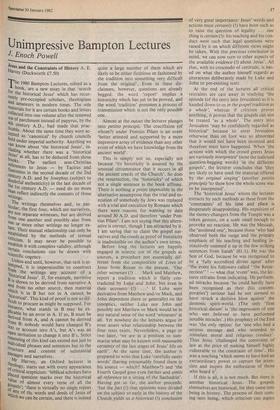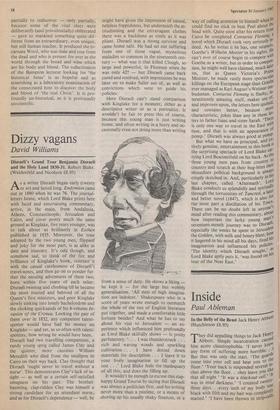Unimpressive Bampton Lectures
J. Enoch Powell
Jesus and the Constraints of History A. E. Harvey (Duckworth £7.50) The 1980 Bampton Lectures, edited as a book, are a new essay in that 'search for the historical Jesus' which has recur- rently pre-occupied scholars, theologians and amateurs in modern times. The sole materials for it are certain books and letters collected into one volume after the renewed use of parchment instead of papyrus, by the 4th century
A.D., had made that prac-
ticable. About the same time they were ac- cepted as 'canonical' by church councils held under imperial authority. Anything we can know about 'the historical Jesus', in-
cluding whether there was a 'historical Jesus' books.at all, has to be deduced from those
The earliest non-Christian references to Jesus — by Tacitus and Suetonius in the second decade of the 2nd century A.D. and by Josephus (subject to doubtful authenticity) in the last decade of the 1st century A.D. — need do no more than reflect indirectly the contents of those writings. The writings themselves and, in par- ticular, the first four, which are narratives, a,,re not separate witnesses, but are derived Itoni one another and possibly also from One or more other writings no longer ex- tant. Their mutual relationship can only be established by the methods of textual criticism. It may never be possible to establish it with complete validity, although certain conclusions can be drawn with scientific cogency. t Unless and until, however, that task is at- tempted, it is impermissible to construct tmn the w usritings any account of a `historical Jes'. If, for example, narrative is shown to be derived from narrative A and from no other source, then material Which is in B but not in A cannot be historical'. This kind of proof is not so dif- ficult to procure as might be supposed. For Instance, what stands in B may be ex-
plicable by an error in A. If so, B must be derived from A, and A cannot be derived
from B: nobody would have changed B's text or account into A's, but A's was an open invitation to change it into B's. Strict reasoning of this kind can extend not just to Individual phrases and sentences but to the structure and content of substantial Passages and narratives. Mr Harvey, an Oxford lecturer in theology, starts out with every appearance Of critical scepticism: 'biblical scholars have placed question marks over the historical gospels'; of almost every verse of all the 6.nsPels'; 'there is virtually no single report Of any of the words and deeds of Jesus of Which we can be certain, and there is indeed
quite a large number of them which are likely to be either fictitious or fashioned by the tradition into something very difficult from the original'. Even in these dis- claimers, however, questions are already begged: the word 'report' implies a historicity which has yet to be proved, and the word 'tradition' presumes a process of transmission which is not the only possible one.
Almost at the outset the lecturer plunges into petitio principii. The crucifixion (of whom?) under Pontius Pilate is an event 'better attested and supported by a more impressive array of evidence than any other event of which we have knowledge from the ancient world'.
This is simply not so, especially not because 'its historicity is assured by the unusual circumstance that it occurs in all the ancient creeds of the Church'. So does the resurrection, the 'historicity' of which not a single sentence in the book affirms. There is nothing a priori impossible in the alternative assumption that the trial and ex- ecution of somebody by Jews was replaced with a trial and execution by Romans which there were reasons for wanting to date around 30 A.D. and therefore 'under Pon- tius Pilate'. I am not saying that this altern- ative is correct, though I am attracted by it. I am saying that to claim the gospel nar- ratives and the creeds as proof of historicity is inadmissible on the author's own terms.
Before long the lectures are happily engaged in eclectic use of the gospels as sources, a procedure not essentially dif- ferent from the composition of Lives of Jesus from Renan to the present. 'Our other witnesses (0 . . . Mark and Matthew, report a tradition which is flatly con- tradicted by Luke and John, but even in their accounts (!) . If Luke were derivative from Matthew and/or Mark, and John dependent (here or generally) on the synoptics, neither Luke nor John and possibly not Matthew or Mark would be in any natural sense of the word 'witnesses' at all. Yet nowhere do the lectures argue or even assert what relationship between the four texts exists. Nevertheless, a page or two later, 'we are in a position to sum- marise what may be known with reasonable certainty of the last stages of Jesus' life on earth'. At the same time, the author is prepared to write that Luke 'carefully omits words' (having presumably found them in his source — which? Matthew?) and 'the Fourth Gospel goes even further and omits all reference to a sitting of the Sanhedrin'. Having got so far, the author proceeds: 'but the fact (!) that opinions were divided on the subject so early in the history of the Church yields us a historical (!) conclusion of very great importance: Jesus' words and actions must certainly (!) have been such as to raise the question of legality ... one thing is certain (!): his teaching and his con- duct were such that legal questions were raised by it on which different views might be taken. With this precious conclusion in mind, we can now turn to other aspects of the available evidence (!) about Jesus'. All that, with its crescendo of certitude, is bas- ed on what the author himself regards as alterations deliberately made by Luke and John to pre-existing texts.
At the end of the lectures all critical restraints are cast away in studying 'the episode (of the entry into Jerusalem) as it is handed down to us in the gospel tradition as a whole', whereas if criticism proves anything, it proves that the gospels can not be treated 'as a whole'. The entry into Jerusalem 'may be confidently regarded as historical' because to enter Jerusalem otherwise than on foot was so abnormal that it would not have been invented and therefore must have happened. When 'the actions with which the crowd greets Jesus are variously interpreted' (note the italicised question-begging words) 'in the different gospels', the lecturer concludes that 'they are likely to have used the material offered by the original singing' (another petitio principii) `to show how the whole scene was to be interpreted'.
The 'historical Jesus' whom the lecturer extracts by such methods as these from the `constraints' of his time and place is desperately disappointing. His expulsion of the money-changers from the Temple was a token gesture, on a scale small enough to provoke no reaction. He was the Messiah, the 'anointed one', because those 'who had observed both the range and the primary emphasis of his teaching and healing in- stinctively summed it up in the few striking sentences from Isaiah' (61.1). He was the Son of God, because he was recognised to be a 'fully accredited divine agent' after 'the event his followers called "the Resur- rection" ' — what that 'event' was, the lec- turer refrains from indicating. He perform- ed miracles because 'he could hardly have been recognised as their (his contem- poraries') saviour had he not seemed to
have struck a decisive blow against' the demonic spirit-world. (The only 'firm historical datum' is 'the impression of one
who was believed to have performed notable miracles'.) His prophecy of the End
was 'the only option' for 'one who had a serious message and who intended to stimulate moral and religious conduct'.
Thus Jesus 'challenged the constraint of law at the price of making himself highly
vulnerable to the constraint of time'. His was a teaching 'which seems to have had an extraordinary power to capture the atten- tion and inspire the enthusiasm of those who heard it'.
If this is all, it is not much. But there is another historical Jesus. The gospels themselves are historical, for they came into being in history. The process of their com- ing into being, which criticism can aspire partially to rediscover — only partially, because some of the vital clues were deliberately (and providentially) obliterated — gave to mankind something quite dif- ferent from an extraordinary, even unique, but still human teacher. It produced the in- carnate Word, who was slain and rose from the dead and who is present for ever in the world through the bread and wine which are his body and blood. The reductionism of the Bampton lecturer looking for 'the historical Jesus' is as hopeful and as nourishing as a laboratory examination of the consecrated host to discover the body and blood of 'the real Christ'. It is pro- foundly un-historical, as it is profoundly unscientific.



































 Previous page
Previous page